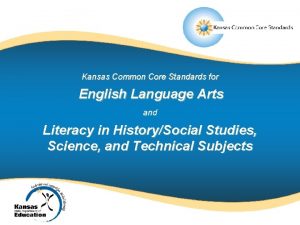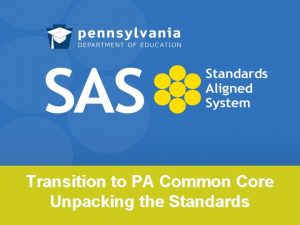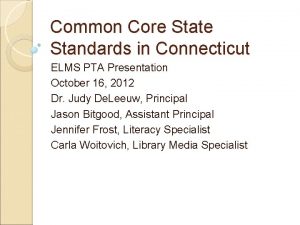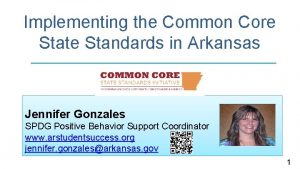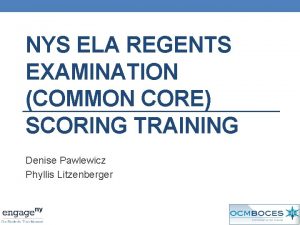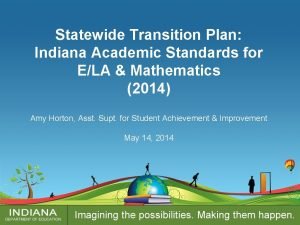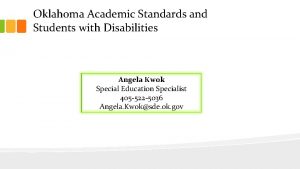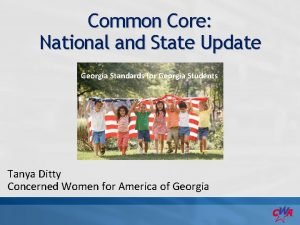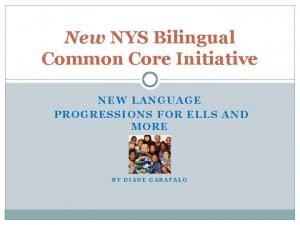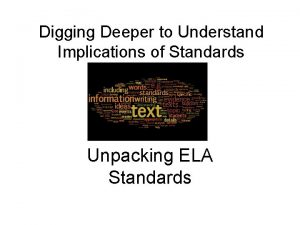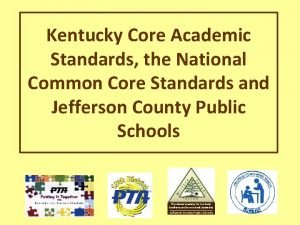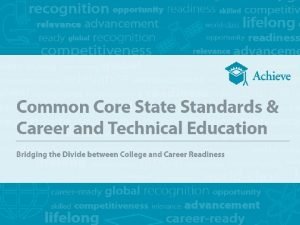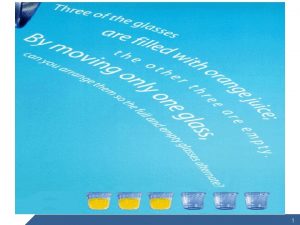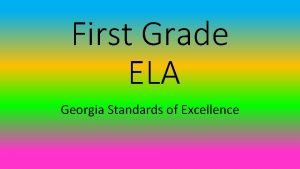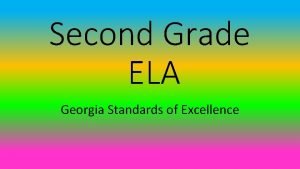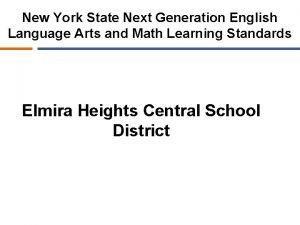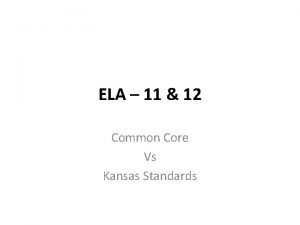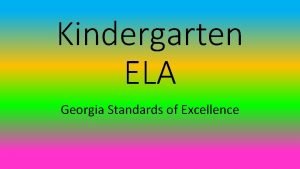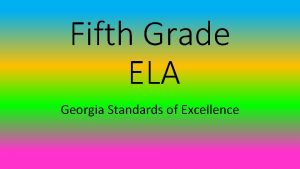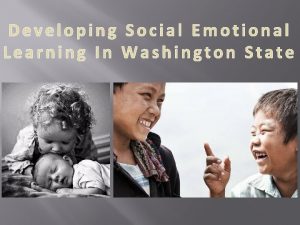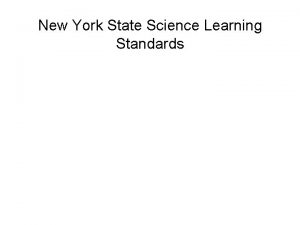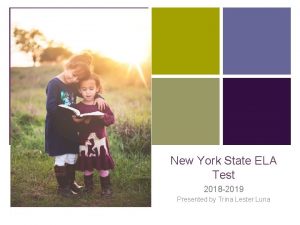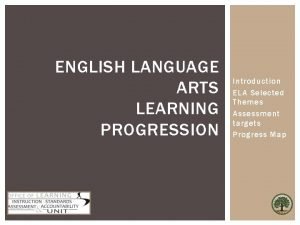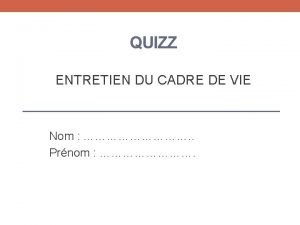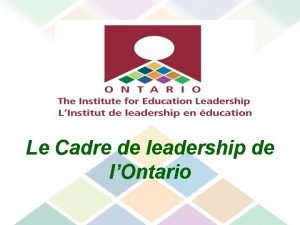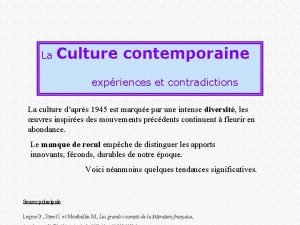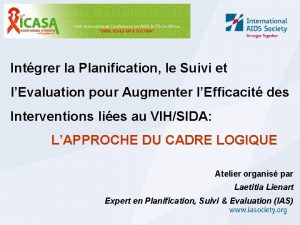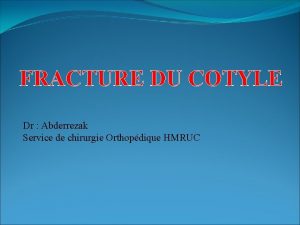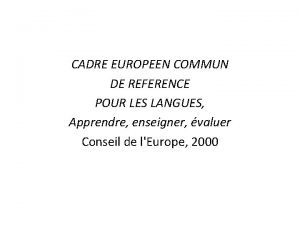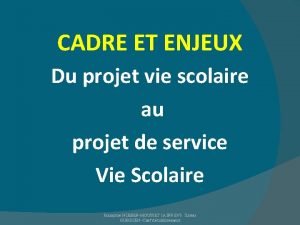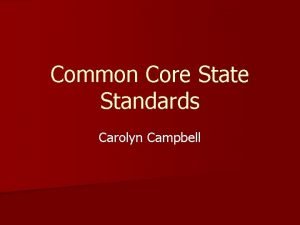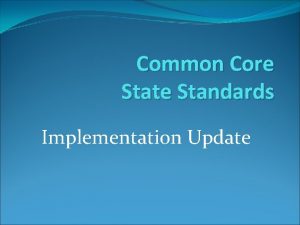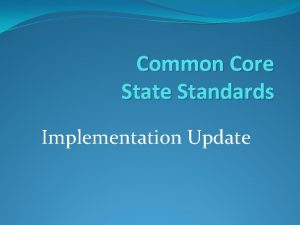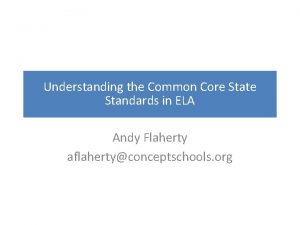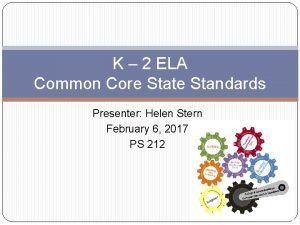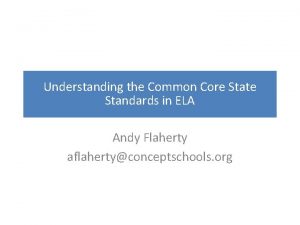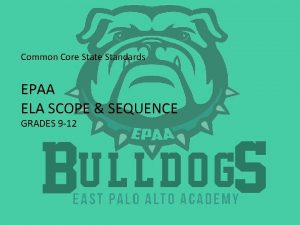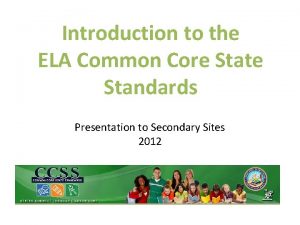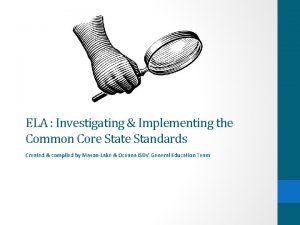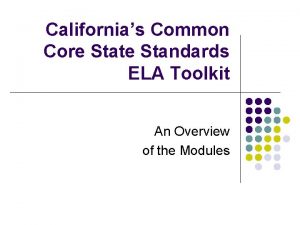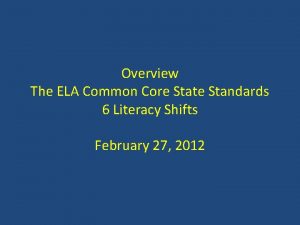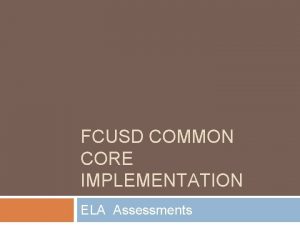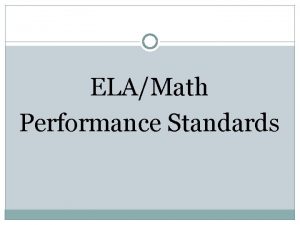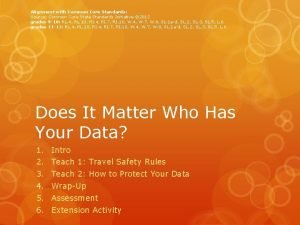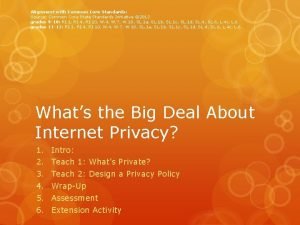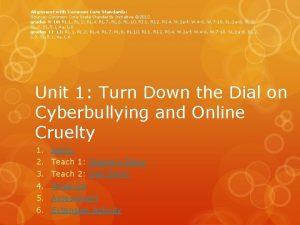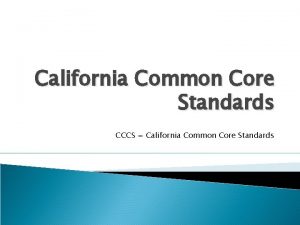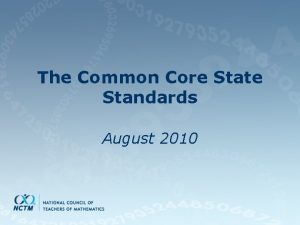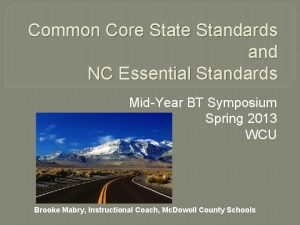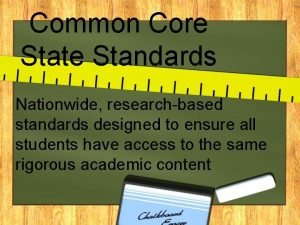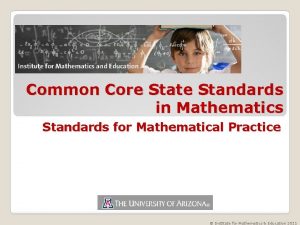ELA Common Core State Standards Digital Learning Cadre


































- Slides: 34

ELA Common Core State Standards Digital Learning Cadre Theresa Bennett ELA, Education Associate January 11, 2013

Agenda • ELA Common Core State Standards (CCSS): – Structure of the Standards – Need for Change – The Shifts

The Background of the Common Core • Initiated by the National Governors Association (NGA) and Council of Chief State School Officers (CCSSO) with the following design principles: – Result in College and Career Readiness – Based on solid research and practice evidence – Fewer, higher, and clearer

Standards for ELA & Literacy in Common Core State History/Social Studies, Science, & Technical Subjects College and Career Readiness (CCR) Standards • Overarching standards for each strand that are further defined by grade-specific standards Grade-Level Standards in English Language Arts • • • K-8, grade-by-grade 9 -10 and 11 -12 grade bands for high school Four strands: Reading, Writing, Speaking and Listening, and Language Standards for Literacy in History/Social Studies, Science, and Technical Subjects • • Standards are embedded at grades K-5 Content-specific literacy standards are provided for grades 6 -8, 910, and 11 -12

READING WRITING 10 Anchor Standards for College and Career Readiness Foundational Skills Literary Text ELA Standards K-12 Inform Text Literacy Standards 6 -12 Hist. / S. S. ELA Standards K-12 Literacy Standards 6 -12 SPEAKING & LISTENING LANGUAGE 6 Anchor Standards for CCR ELA Standards K-12 Sci. / Tech Subj. →→→→→→ K 1 2 →→→→→→ 2 2 3→→→→→ 3 →→→→→→ 3 3 4 4 4 →→→→→→ 4 4 5 5 5 →→→→→→ 5 5 6 6 7 7 8 8 K K 1 1 K 1 2 2 2 3 3 4 5 →→→→→→→→→→ → →→→→→→ → 6 -8 K 1 →→→→→→ 6 6 -8 7 6 -8 8 9 -10 9 -10 11 -12 11 -12 5 Adapted from Kansas

Structure of the Standards • Four Strands: Reading, Writing, Speaking and Listening, Language • Reading and Writing = 10 Anchor Standards; Speaking & Listening and Language = 6 Anchor Standards • Text complexity standards are listed by grade “bands”: K-1, 2 -3, 4 -5, 6 -8, 9 -10, 11 -12, CCR – College and Career Ready) 3 RL 1 Grade Strand Standard Strand Anchor Standard Grade. Specific Standard

College & Career Anchor Standards for Reading Standards Big Ideas 1 -Evidence 2 -Central Ideas 3 -Interaction Getting deep into the text 4 -Vocabulary 5 -Text Structure 6 -Point of View/Purpose Author’s choices about the text 7 -Multimedia 8 -Argument (Evaluating Argument) 9 -Mutliple Texts Thinking across texts 10 -Range and Complexity LOTS of in-school reading

College & Career Anchor Standards for Writing Standards 1 -Write arguments 2 -Write to explain/inform 3 -Write narratives Big Ideas Types of writing 4 -Write with coherence 5 -Plan, revise, rewrite 6 -Use technology Writing Process 7 -Short and sustained research 8 -Use multiple sources 9 -Use text evidence Research 10 -Range of writing LOTS of in-school writing

College & Career Anchor Standards for Speaking & Listening Standards 1 -Range of conversations 2 -Integrate and evaluate 3 -Evaluate speaker’s point of view 4 -Present information clearly, know your audience 5 -Use digital media 6 -Adapts speech to context Big Ideas Comprehension and collaboration (LOTS of in-school discussions) Presentation of knowledge and ideas

College & Career Anchor Standards for Language Standards 1 -Command of grammar and usage 2 -Command of punctuation and spelling 3 -Use knowledge of language 4 -Vocabulary—use context clues 5 -Vocabulary—use figurative language 6 -Vocabulary—use academic language Big Ideas Embedded in use of skills (Not in isolation) Craft choices (Not in isolation)

GLEs and CCSS GLE GLE CCSS

What and How • ELA CCSS = What • Shifts in ELA = How Ø In order to ensure these new standards prepare Delaware’s students to be college and career ready, educators need to focus on the “big” shifts that affect ELA.

The “Big” Instructional Shifts • Building knowledge through content-rich literary nonfiction and informational texts • Reading and writing grounded in evidence from the text • Regular practice with complex text and its academic vocabulary Revised Publishers’ Criteria, K-2 and 3 -12

David Coleman and Sue Pimental • http: //tinyurl. com/cod 6 ooj

3 Shifts 6 Shifts 1. Building knowledge through PK-5, Balance of informational content-rich literary nonfiction and literary text informational texts. 6 -12, Building knowledge in the disciplines 2. Reading and writing grounded in evidence from text. Text-based answers Writing to/from sources 3. Regular practice with complex text and its academic vocabulary. Staircase of complexity Academic vocabulary

Critical Conversations About “The Big Shifts” READING 1. Informational text must be studied in addition to literature. 2. Foundational reading skills are more specifically defined K-5. 3. Text complexity and range of text types is more specifically defined to ensure consistency and rigor. 4. Close reading is required for acquiring knowledge from text and deepening comprehension. 5. Technology is viewed as more than a tool; it changes reading and reading instruction.

Critical Conversations About “The Big Shifts” WRITING 1. Narrative, informative/explanatory, and opinion/argument writing are emphasized. 2. Writing exemplars are included to ensure consistent rigorous expectations for student writing. 3. Research and inquiry are emphasized as processes rather than a text type. 4. Technology is viewed as more than a tool; it changes writing and writing instruction.

Critical Conversations About “The Big Shifts” SPEAKING and LISTENING 1. Discussion is viewed as a key component of learning and shared knowledge. 2. Speaking and listening are viewed as embedded aspects of every English Language Arts classroom. 3. Technology is viewed as more than a tool; it changes the way speaking and listening occurs.

Critical Conversations About “The Big Shifts” LANGUAGE 1. Punctuation and grammar instruction must occur in embedded and authentic contexts. 2. Vocabulary instruction must be intentional and occur in authentic contexts.

Shift #1: PK-5, Balance of Informational and Literary Text • Rationale: Elementary students typically encounter curriculum that is heavily influenced by literary text. • Implications for Instruction: Elementary students need a balance (50/50); they need to learn the structures of both literary and informational text to deepen comprehension.

Shift #2: 6 -12, Building Knowledge in the Disciplines • Rationale: Literacy needs to be owned by all. • Implications for Instruction: Students need an opportunity to read a variety of discipline-specific texts – Literary Nonfiction and Informational Text for ELA – Discipline-specific texts across other content areas

The percentages on the table reflect the sum of student reading, not just reading in ELA settings. Teachers of senior English classes, for example, are not required to devote 70 percent of reading to informational texts. Rather, 70 percent of student reading across the grade should be informational. (P. 5 CCSS)

Shift #3: Staircase of Complexity • Rationale: All students need to read a range of texts; they need appropriate scaffolding to be able to read closely and analyze challenging text. • Implications for Instruction: Choose short and extended texts that represent a range. Teach students how to choose books (independent, challenging, just right). Model how to read closely and analyze text. Let students productively struggle.

Shift #4: Text-Based Answers • Rationale: Students need to discuss/ answer text-dependent questions – not text-inspired or “cookie cutter” • Implications for Instruction: Teachers need to ask text-based questions and teach students how to refer back to the text to gather evidence. Encourage students to use text-dependent questions during discussions.

Shift #5: Writing From Sources • Rationale: Students need to learn how to gather evidence to marshal an argument, using multiple sources. • Implications for Instruction: Students need to do purposeful writing that requires text evidence. Short, focused research, using multiple texts, needs to be a staple in a unit.

Shift #6: Academic Vocabulary • Rationale: Teachers need to spend more time on academic vocabulary (Tier 2). • Implications for Instruction: Tier 2 vocabulary (or academic vocabulary) exposes students to multi-meaning words that transcend all content areas. Tier 3 vocabulary is domain or disciplinespecific and should be encountered in the content-area classroom in an authentic context.

What do the Shifts signify? Content “What” Instruction “How” Assessment “What + How”

Integrated Model of Literacy • An integrated model of literacy gives students the opportunity to find logical and purposeful connections among texts using reading skills and strategies. • An important feature of the ELA Common Core State Standards is the representation of reading comprehension skills in a similar manner across informational text and literature • (Liebling & Meltzer, 2011)

That was then…this is now. • Literary Unit – – Story Map Predictions Author’s Purpose Writer’s Workshop – Narrative • Informational Unit • Research Unit • Theme/Unit – Text Structures for both literary and informational – Gather evidence for both literary and informational – Author’s purpose/ perspective both – Writer’s workshop that includes both opinion or informational and narrative writing – Integrated research

What does it mean to be ELA Common Core-Ready? • There is an understanding of the CCSS Structure – Reading – Writing – Speaking & Listening – Language • There is an understanding of the shifts • implications for instruction • Implications for assessment • There is an understanding of the Publishers’ Criteria • to ensure alignment of materials with the Standards • to provide a clear and consistent framework

Digital Literacy Standards • W 6: Use technology, including the Internet, to produce and publish writing and to interact and collaborate with others. • W 8: Gather relevant information from multiple print and digital sources, assess the credibility and accuracy of each source, and integrate the information while avoiding plagiarism

• RI 7: Integrate and evaluate content presented in diverse formats, including visually and quantitatively, as well as in words. • RL 7: Integrate and evaluate content presented in diverse formats, including visually and quantitatively, as well as in words.

• SL 2: Integrate and evaluate information presented in diverse media and formats, including visually, quantitatively, and orally. • SL 5: Make strategic use of digital media and visual displays of data to express information and enhance understanding of presentations.

CCSS Resources • Guide to the ELA Shifts: http: //www. doe. k 12. de. us/commoncore/el a/files/ELAInstructional. Shifts. pdf • SBAC Performance Tasks: http: //dese. mo. gov/divimprove/assess/sb ac. html#sbaccample • HQPD Modules: http: //www. doe. k 12. de. us/commoncore/el a/admintoolkit/hqpd. shtml
 Kansas common core standards ela
Kansas common core standards ela Unpacking common core standards
Unpacking common core standards Common core state standards ct
Common core state standards ct Common core state standards missouri
Common core state standards missouri Common core state standards arkansas
Common core state standards arkansas Ela common core regents
Ela common core regents Common core ela assessments
Common core ela assessments Termidoe
Termidoe Oklahoma state standards ela
Oklahoma state standards ela Georgia common core standards
Georgia common core standards Nlap standards
Nlap standards Unpacking standards worksheet
Unpacking standards worksheet Common core standards ky
Common core standards ky Common career technical core standards
Common career technical core standards Achieve the core ela
Achieve the core ela First grade georgia standards
First grade georgia standards Georgia reading standards 2nd grade
Georgia reading standards 2nd grade Nys ela standards
Nys ela standards Kansas ela standards
Kansas ela standards Georgia kindergarten reading standards
Georgia kindergarten reading standards Elagse
Elagse Social emotional learning standards washington state
Social emotional learning standards washington state New york state learning standards science
New york state learning standards science 2018 nys ela exam
2018 nys ela exam Ela learning progressions
Ela learning progressions Learning progressions ela
Learning progressions ela Quizz bionettoyage
Quizz bionettoyage Exemple de cadre logique d'un projet de formation
Exemple de cadre logique d'un projet de formation Cadre de leadership de l'ontario
Cadre de leadership de l'ontario Cadre temporel
Cadre temporel Exemple de cadre logique d'un projet de formation
Exemple de cadre logique d'un projet de formation Cadre obturateur
Cadre obturateur Traction trans tibiale
Traction trans tibiale Cadre commun europeen reference pour langues
Cadre commun europeen reference pour langues Projet vie scolaire
Projet vie scolaire
